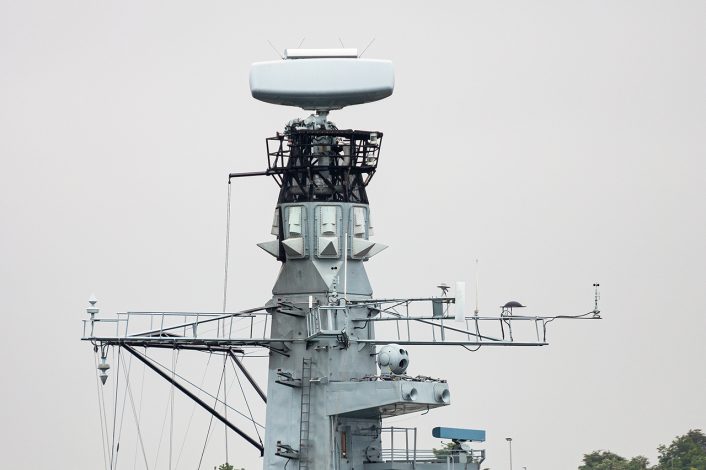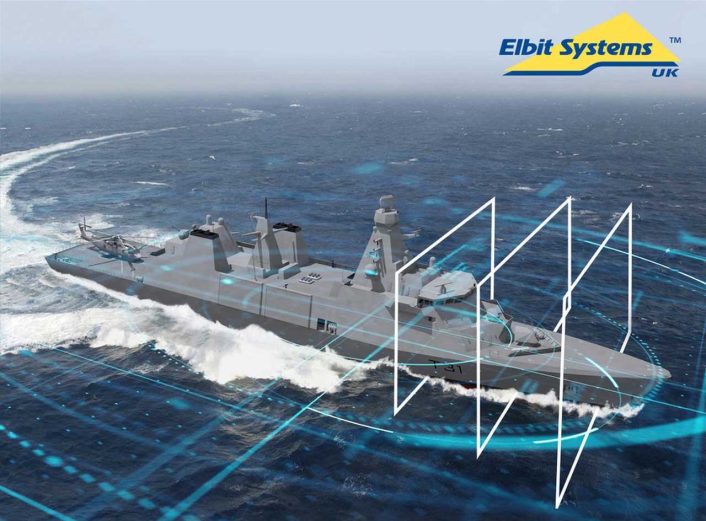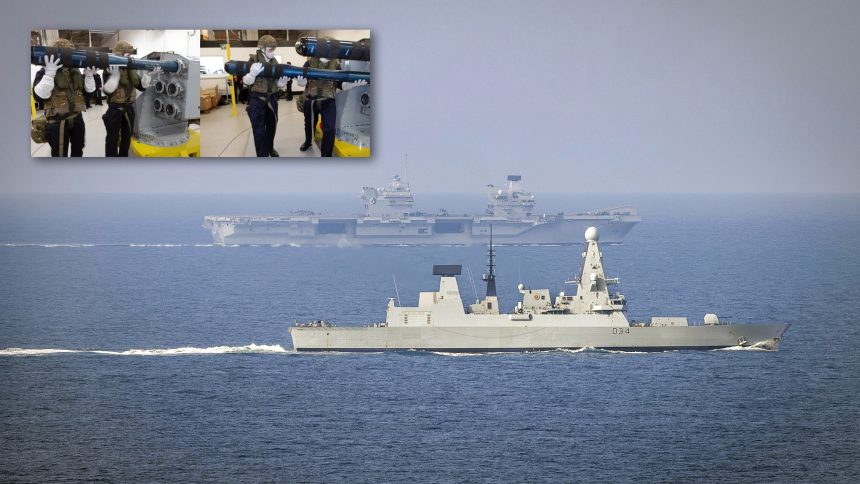The Maritime Electronic Warfare System Integrated Capability (MEWSIC) will be integrated onto Type 26 and Type 31 frigates, Type 45 destroyers, and the two Queen Elizabeth class aircraft carriers.
Maritime Electronic Warfare System Integrated Capability, commonly referred to as MEWSIC (pronounced ‘music’), will become the Royal Navy’s primary electronic warfare (EW) suite, comprising a new EW Command and Control system combined with Radar Electronic Support Measures (R-ESM). It will equip the Royal Navy’s entire surface combatant fleet alongside the Queen Elizabeth class aircraft carriers.
Developed by Elbit Systems UK in conjunction with UK companies Qinetiq and Babcock, the £73 million contract for MEWSIC Increment 1 was awarded in 2021. It includes production and delivery of the systems as well as 13 years of ongoing in-service support. Follow-on support and future upgrades will likely be provided for by subsequent increment contracts.
Electronic warfare systems are an under-discussed but vital capability of modern warships, providing not only for ship and fleet defense against kinetic and electronic threats but also for intelligence gathering on the electronic systems of other nations. A comprehensive EW suite can turn any ship into a potent mobile intelligence asset, most importantly without the inherent conspicuity of a dedicated intelligence ship.
The current most visible element of EW systems on Royal Navy ships are the Thales UAT R-ESM antennas fitted around the radar masts of Type 23 frigates, Type 45 destroyers, and the Queen Elizabeth class aircraft carriers. The same installations were also used on the Albion class amphibious assault ships, Invincible class aircraft carriers, and the helicopter carrier HMS Ocean, as all three of these had radar masts derived to some degree from the Royal Navy’s surface combatants. Royal Fleet Auxiliary stores ship RFA Fort Victoria is also equipped with Thales UAT antennas, likely as a result of the class originally being envisioned as a Type 23 frigate ‘mothership’ equipped with the Sea Wolf point defense missile system.

Presumably, a replacement of the Thales UAT antennas will be included in the Elbit Systems package, though many renderings of the Type 26 frigates still show the UAT style antennas. It may be the case that the first ships of the class are delivered with the existing system before a future upgrade, allowing MEWSIC to be tested in service on established platforms like the Type 45 first.
Renderings of the Type 31 have been slightly more vague, not showing as much discernable detail for its EW and communications systems. Elbit Systems UK, though, has used a Type 31 frigate rendering as part of its marketing for MEWSIC.

For signals intelligence (SIGINT) the Type 26 will be equipped with the AN/SSQ-130(V) Shipboard Signals Exploitation Equipment (SSEE) derived Shaman C-ESM that has been installed as an upgrade for Type 45 destroyers.
Ancilia: A Trainable Countermeasures Launcher
Planned for operation alongside MEWSIC under the Royal Navy’s Maritime Electronic Warfare Programme (MEWP) is the Systems Engineering and Assessment (SEA) Ancilia countermeasures launcher.
This turret-like system is designed to be compatible with all existing NATO standard 130mm ship-borne decoy munitions, carrying a combination of 12 different effectors at any one time. It replaces Seagnat, also designed by SEA, which utilizes fixed banks of mortar tubes. While these are incredibly simple, their fixed nature requires the entire ship to maneuver in order to provide the best chance of a successful countermeasure deployment. As a trainable turret, Ancilia can simply slew in any direction to face an incoming threat, like a Phalanx CIWS.
This will replace the obsolete fixed Outfit DLH / Sea Gnat system currently in RN service. The trainable launcher provides faster reaction times.https://t.co/1hvQKRklLZ pic.twitter.com/UxViP3j3E0
— Navy Lookout (@NavyLookout) March 26, 2024
Ancilia not only allows for countermeasures to be deployed in the right direction against an incoming threat, but it also allows for countermeasures to be launched at specific angles. This type of control is not at all possible with the current Seagnat system.
Royal Navy personnel are being trained on the loading and operation of the first production Ancilia launcher. Eventually, two launchers will be equipped on each of the Royal Navy’s frigates and destroyers. The launchers will be integrated with MEWSIC, allowing crew members a much more cohesive EW self-defense capability and providing for an intelligent automatic countermeasure deployment capability.
Decoy launchers can employ typical smoke, chaff, and infra-red countermeasures, manufactured by UK supplier Chemring, as well as more advanced capabilities like active RF decoys. Chemring’s Large Payload Carrier can additionally adapt the 130mm standard sized mortar into a larger 170mm diameter effector. Chemring says that this capability supports “a variety of payloads including Chaff, ASW, Obscurants and anti-piracy solutions”.
Interestingly, though previously the subject of much media discussion, Chemring’s own trainable countermeasure launcher – named Centurion – was not successful in gaining a Royal Navy contract. Safran Electronics & Defense’s proposal, modeled on systems developed for the French Navy, was also unsuccessful.
This is an older and brief video Clip that showcased the Chemring Centurion trainable naval countermeasures system, but with Javelin for use in the counter fast attack craft role. pic.twitter.com/AkHRLTfwLL
— Think Defence (@thinkdefence) August 30, 2024
The Centurion, a circular rotating design that fully encloses the loaded munitions in a radar cross-section reducing housing, offered a proven capability to even launch surface to surface missiles like the FGM-148 Javelin.

A key concern raised by outside commentators for all of these systems is what would happen should the system fail. Compared to Seagnat, all trainable launchers introduce a significant amount of moving parts and new points of potential failure. This is, perhaps, where Ancilia has an advantage over Centurion.
While this level of engineering detail can only be speculated upon at this stage, the physical design of Ancilia would theoretically allow countermeasures to be launched even if the launcher is not able to move, essentially regressing to the current fixed implementation. Centurion, on the other hand, requires moving parts to prepare each mortar barrel for firing – were any of these parts to fail, the decoys would simply be unusable.









